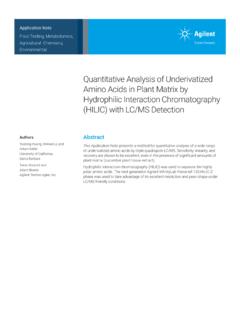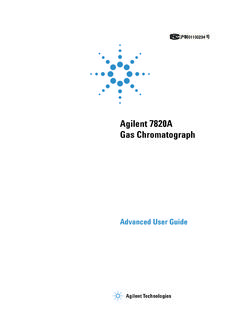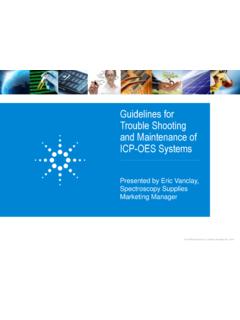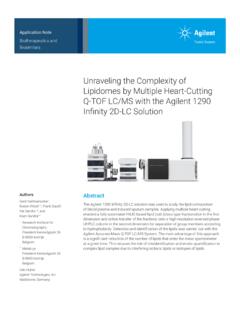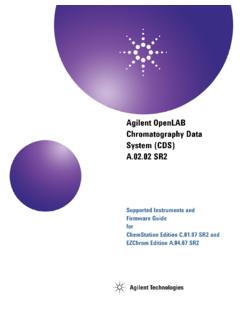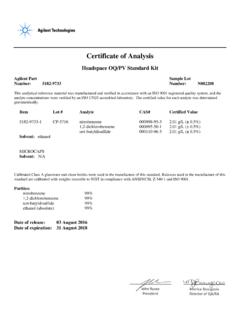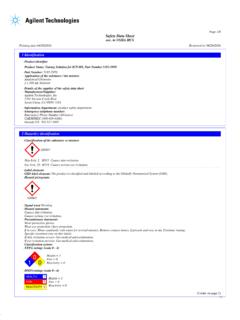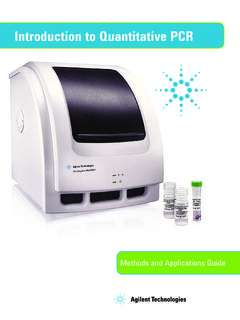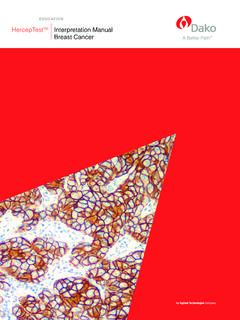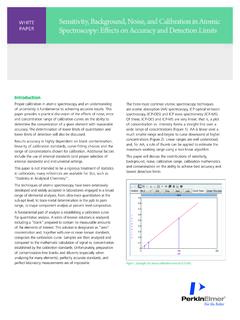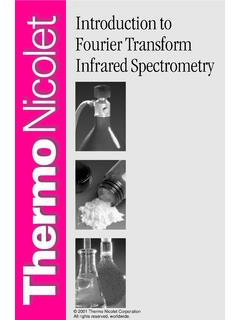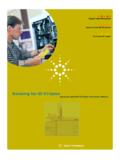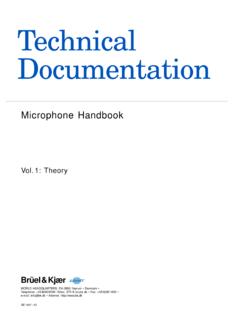Transcription of Signal, Noise, and Detection Limits in Mass Spectrometry
1 Application NoteChemical AnalysisAuthorsGreg Wells, Harry Prest, and Charles William Russ IV, Agilent Technologies, Inc. AbstractIn the past, the signal-to- noise of a chromatographic peak determined from a single measurement has served as a convenient figure of merit used to compare the performance of two different MS systems. Design evolution of mass Spectrometry instrumentation has resulted in very low noise systems that have made the comparison of performance based upon signal-to- noise increasingly difficult, and in some modes of operation impossible. This is especially true when using ultra-low noise modes such as high resolution mass Spectrometry or tandem MS; where there are often no ions in the background and the noise is essentially zero.
2 Statistical methodology commonly used to establish method Detection Limits for trace analysis in complex matrices as a means of characterizing instrument performance is shown to be valid for high and low background noise , noise , and Detection Limits in Mass Spectrometry2 IntroductionTrace analysis in analytical chemistry generally requires establishing the limit of Detection (LOD, or simply Detection limit), which is the lowest quantity of a substance that can be distinguished from the system noise absent of that substance (a blank value). Mass spectrometers are increasing used for trace analysis, and an understanding of the factors that affect the estimation of analyte Detection Limits is important when using these instruments.
3 There are a number of different Detection Limits commonly used. These include the instrument Detection limit (IDL), the method Detection limit (MDL), the practical quantification limit (PQL), and the limit of quantification (LOQ). Even when the same terminology is used, there can be differences in the LOD according to nuances of what definition is used and what type of noise contributes to the measurement and calibration . There is much confusion regarding figures of merit for instrument performance such as sensitivity , noise , signal-to- noise ratio and Detection Limits . An understanding of the factors that contribute to these figures of merit and how they are determined is important when estimating and reporting Detection Limits .
4 Modern mass spectrometers, which can operate in modes that provide very low background noise and have the ability to detect individual ions, offer new challenges to the traditional means of determining Detection Instrument background signal The signal output from the instrument when a blank is measured; generally a voltage output that is digitized by an analog to digital converter. noise (N) The fluctuation in the instrument background signal; generally measure as the standard deviation of the background signal. Analyte signal (S) The change in instrument response to the presence of a substance. Total instrument signal The sum of the analyte signal and the instrument background signal. Signal-to- noise ratio (S/N) The ratio of the analyte signal to the noise measured on a blank.
5 sensitivity The signal response to a particular quantity of analyte normalized to the amount of analyte giving rise to the response; generally determined by the slope of the calibration curve. sensitivity is often used interchangeably with terms such as S/N and LOD. For the purpose of this document, sensitivity will only apply to this analytical Detection limit (IDL)Most analytical instruments produce a signal even when a blank (matrix without analyte) is analyzed. This signal is referred to as the instrument background level. noise is a measure of the fluctuation of the background level. It is generally measured by calculating the standard deviation of a number of consecutive point measurements of the background signal.
6 The instrument Detection limit (IDL) is the analyte concentration required to produce a signal that is distinguishable from the noise level within a particular statistical confidence limit. Approximate estimate of LOD can be obtained from the signal-to- noise ratio (S/N) as described in this document. Method Detection limit (MDL)For most applications, there is more to the analytical method than just analyzing a clean analyte. It might be necessary to remove unwanted matrix components, extract and concentrate the analyte, or even derivatize the analyte for improved chromatography or Detection . The analyte may also be further diluted or concentrated prior to analysis on an instrument. Additional steps in an analysis add additional opportunities for error.
7 Since Detection Limits are defined in terms of error, this will increase the measured Detection limit. This Detection limit (with all steps of the analysis included) is called the MDL. An approximate estimate of LOD can often be obtained from the S/N of the analyte measured in matrix. Limit of quantification (LOQ) and practical limit of quantification (PQL)Just because we can tell something from noise does not mean that we can necessarily know how much of the material there actually is with a particular degree of certainty. Repeated measurements of the same analyte under the same conditions, even on the same instrument, give slightly different results each time due to variability of sample introduction, separation, and detections processes in the instrument.
8 The LOQ is the limit at which we can reasonably tell the difference between two different values of the amount of analyte. The LOQ can be drastically different between labs so another Detection limit referred to as the Practical Quantitation Limit (PQL) is commonly used. There is no specific mathematical relationship between the PQL and the LOQ based on statistics. The PQL is often practically defined simply as about 5 to 10 times the IDL and MDL using signal to noiseMass Spectrometry measurements of an analyte generally use a chromatograph as a means of sample introduction. The resulting analyte signal from a chromatograph will have an approximately Gaussian shaped distribution as a function of time (Figure 1). In the case of chromatographic analyte introduction into the MS instrument, the signal is not constant and does not represent the same analyte amount at all points of the sample set.
9 For the purpose of estimating Detection Limits by using signal-to- noise ratios, the measurement of the signal is generally accepted to be the height of the maximum of the chromatographic signal (S in Figure 1) above the baseline ( B), and an estimate of the background noise under the peak must be made. A standard for estimating the noise is to measure the peak-to-peak (minimum to maximum) value of baseline noise , away from the peak tails, for 60 seconds before the peak (Figure 1) or 30 seconds before and after the peak. With the advent of modern integrator and data systems, the baseline segments for estimation of noise are auto-selected, and noise is calculated as the standard deviation (STD) or root-mean-square (RMS) of the baseline over the selected time window.
10 However, it will be shown that the single measurement S/N approach fails in many 1. Analyte signal as a function of time for a chromatographic peak, demonstrating the time dependence in the amount of analyte a quantitative measurement of the amount of analyte is made, the signal is the total integrated signal of the Gaussian peak from start to end with the background subtracted. This area is a single sampling measurement and is a single point estimator for the true analyte amount in the population (that is, the amount of analyte in the original sample). The amount of analyte as a function of time can be expressed as: C(t) = KC0F(t); where C0 is the amount of analyte in the test sample, F(t) is the shape of the chromatographic peak (amplitude versus time), and K is a calibration factor.
